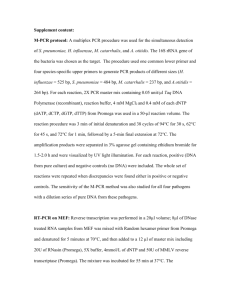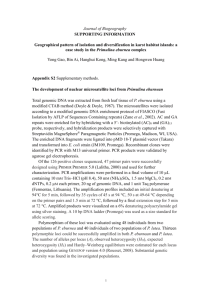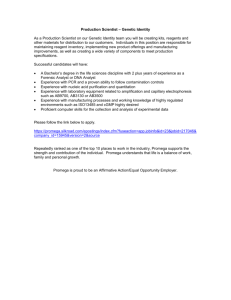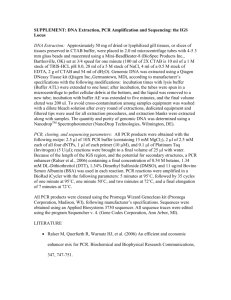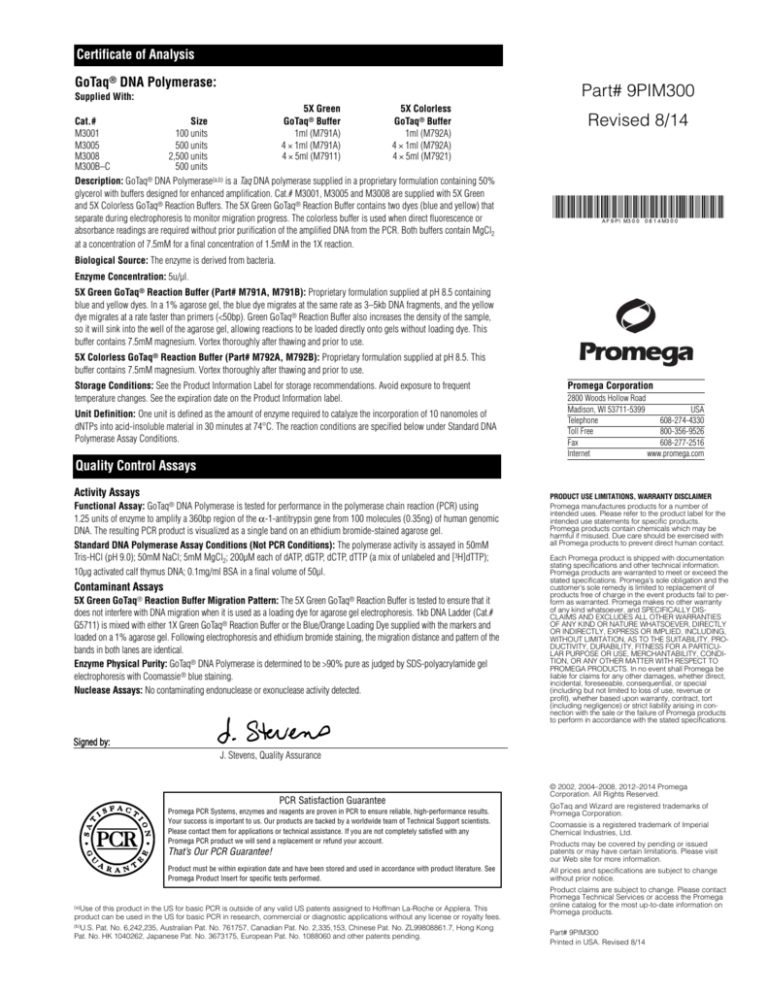
Certificate of Analysis
GoTaq® DNA Polymerase:
Part# 9PIM300
Supplied With:
5X Green
GoTaq® Buffer
1ml (M791A)
4 × 1ml (M791A)
4 × 5ml (M7911)
5X Colorless
GoTaq® Buffer
1ml (M792A)
4 × 1ml (M792A)
4 × 5ml (M7921)
Cat.#
Size
M3001
100 units
M3005
500 units
M3008
2,500 units
M300B–C
500 units
Description: GoTaq® DNA Polymerase(a,b) is a Taq DNA polymerase supplied in a proprietary formulation containing 50%
glycerol with buffers designed for enhanced amplification. Cat.# M3001, M3005 and M3008 are supplied with 5X Green
and 5X Colorless GoTaq® Reaction Buffers. The 5X Green GoTaq® Reaction Buffer contains two dyes (blue and yellow) that
separate during electrophoresis to monitor migration progress. The colorless buffer is used when direct fluorescence or
absorbance readings are required without prior purification of the amplified DNA from the PCR. Both buffers contain MgCl2
at a concentration of 7.5mM for a final concentration of 1.5mM in the 1X reaction.
Revised 8/14
Biological Source: The enzyme is derived from bacteria.
Enzyme Concentration: 5u/µl.
5X Green GoTaq® Reaction Buffer (Part# M791A, M791B): Proprietary formulation supplied at pH 8.5 containing
blue and yellow dyes. In a 1% agarose gel, the blue dye migrates at the same rate as 3–5kb DNA fragments, and the yellow
dye migrates at a rate faster than primers (<50bp). Green GoTaq® Reaction Buffer also increases the density of the sample,
so it will sink into the well of the agarose gel, allowing reactions to be loaded directly onto gels without loading dye. This
buffer contains 7.5mM magnesium. Vortex thoroughly after thawing and prior to use.
5X Colorless GoTaq® Reaction Buffer (Part# M792A, M792B): Proprietary formulation supplied at pH 8.5. This
buffer contains 7.5mM magnesium. Vortex thoroughly after thawing and prior to use.
Storage Conditions: See the Product Information Label for storage recommendations. Avoid exposure to frequent
temperature changes. See the expiration date on the Product Information label.
Unit Definition: One unit is defined as the amount of enzyme required to catalyze the incorporation of 10 nanomoles of
dNTPs into acid-insoluble material in 30 minutes at 74°C. The reaction conditions are specified below under Standard DNA
Polymerase Assay Conditions.
Promega Corporation
2800 Woods Hollow Road
Madison, WI 53711-5399
USA
Telephone
608-274-4330
Toll Free
800-356-9526
Fax
608-277-2516
Internet
www.promega.com
Quality Control Assays
Activity Assays
Functional Assay: GoTaq® DNA Polymerase is tested for performance in the polymerase chain reaction (PCR) using
1.25 units of enzyme to amplify a 360bp region of the α-1-antitrypsin gene from 100 molecules (0.35ng) of human genomic
DNA. The resulting PCR product is visualized as a single band on an ethidium bromide-stained agarose gel.
Standard DNA Polymerase Assay Conditions (Not PCR Conditions): The polymerase activity is assayed in 50mM
Tris-HCl (pH 9.0); 50mM NaCl; 5mM MgCl2; 200µM each of dATP, dGTP, dCTP, dTTP (a mix of unlabeled and [3H]dTTP);
10µg activated calf thymus DNA; 0.1mg/ml BSA in a final volume of 50µl.
Contaminant Assays
5X Green GoTaq® Reaction Buffer Migration Pattern: The 5X Green GoTaq® Reaction Buffer is tested to ensure that it
does not interfere with DNA migration when it is used as a loading dye for agarose gel electrophoresis. 1kb DNA Ladder (Cat.#
G5711) is mixed with either 1X Green GoTaq® Reaction Buffer or the Blue/Orange Loading Dye supplied with the markers and
loaded on a 1% agarose gel. Following electrophoresis and ethidium bromide staining, the migration distance and pattern of the
bands in both lanes are identical.
Enzyme Physical Purity: GoTaq® DNA Polymerase is determined to be >90% pure as judged by SDS-polyacrylamide gel
electrophoresis with Coomassie ® blue staining.
Nuclease Assays: No contaminating endonuclease or exonuclease activity detected.
PRODUCT USE LIMITATIONS, WARRANTY DISCLAIMER
Promega manufactures products for a number of
intended uses. Please refer to the product label for the
intended use statements for specific products.
Promega products contain chemicals which may be
harmful if misused. Due care should be exercised with
all Promega products to prevent direct human contact.
Each Promega product is shipped with documentation
stating specifications and other technical information.
Promega products are warranted to meet or exceed the
stated specifications. Promega's sole obligation and the
customer's sole remedy is limited to replacement of
products free of charge in the event products fail to perform as warranted. Promega makes no other warranty
of any kind whatsoever, and SPECIFICALLY DISCLAIMS AND EXCLUDES ALL OTHER WARRANTIES
OF ANY KIND OR NATURE WHATSOEVER, DIRECTLY
OR INDIRECTLY, EXPRESS OR IMPLIED, INCLUDING,
WITHOUT LIMITATION, AS TO THE SUITABILITY, PRODUCTIVITY, DURABILITY, FITNESS FOR A PARTICULAR PURPOSE OR USE, MERCHANTABILITY, CONDITION, OR ANY OTHER MATTER WITH RESPECT TO
PROMEGA PRODUCTS. In no event shall Promega be
liable for claims for any other damages, whether direct,
incidental, foreseeable, consequential, or special
(including but not limited to loss of use, revenue or
profit), whether based upon warranty, contract, tort
(including negligence) or strict liability arising in connection with the sale or the failure of Promega products
to perform in accordance with the stated specifications.
Signed by:
J. Stevens, Quality Assurance
PCR Satisfaction Guarantee
Promega PCR Systems, enzymes and reagents are proven in PCR to ensure reliable, high-performance results.
Your success is important to us. Our products are backed by a worldwide team of Technical Support scientists.
Please contact them for applications or technical assistance. If you are not completely satisfied with any
Promega PCR product we will send a replacement or refund your account.
(a)Use
© 2002, 2004–2008, 2012–2014 Promega
Corporation. All Rights Reserved.
GoTaq and Wizard are registered trademarks of
Promega Corporation.
Coomassie is a registered trademark of Imperial
Chemical Industries, Ltd.
That’s Our PCR Guarantee!
Products may be covered by pending or issued
patents or may have certain limitations. Please visit
our Web site for more information.
Product must be within expiration date and have been stored and used in accordance with product literature. See
Promega Product Insert for specific tests performed.
All prices and specifications are subject to change
without prior notice.
of this product in the US for basic PCR is outside of any valid US patents assigned to Hoffman La-Roche or Applera. This
product can be used in the US for basic PCR in research, commercial or diagnostic applications without any license or royalty fees.
(b)U.S. Pat. No. 6,242,235, Australian Pat. No. 761757, Canadian Pat. No. 2,335,153, Chinese Pat. No. ZL99808861.7, Hong Kong
Pat. No. HK 1040262, Japanese Pat. No. 3673175, European Pat. No. 1088060 and other patents pending.
Product claims are subject to change. Please contact
Promega Technical Services or access the Promega
online catalog for the most up-to-date information on
Promega products.
Part# 9PIM300
Printed in USA. Revised 8/14
Usage Information
1. Standard Application
B. Buffer Choice
Reagents to Be Supplied by the User
•
•
PCR Nucleotide Mix (Cat.# C1141,
C1145)
Nuclease-Free Water (Cat.# P1193)
•
•
•
upstream primer
downstream primer
template DNA
1. In a sterile, nuclease-free microcentrifuge tube, combine the following on ice:
Component
Final Volume
Final Concentration
10µl
1µl
Xµl
Yµl
0.25µl
Zµl
50µl
1X (1.5mM MgCl2)2
0.2mM each dNTP
0.1–1.0µM
0.1–1.0µM
1.25u
<0.5µg/50µl
5X Green or Colorless
GoTaq® Reaction Buffer1
PCR Nucleotide Mix, 10mM each
upstream primer
downstream primer
GoTaq® DNA Polymerase (5u/µl)
template DNA
Nuclease-Free Water to
1Completely
2More
thaw and thoroughly vortex the buffer prior to use.
MgCl2 can be added to the reaction using 25mM MgCl2 Solution (Cat.# A3511).
2. If using a thermal cycler without a heated lid, overlay the reaction mix with 1–2 drops
(approximately 50µl) of mineral oil to prevent evaporation during thermal cycling.
Centrifuge the reactions in a microcentrifuge for 5 seconds.
3. Perform PCR using your standard parameters. An example profile is given in Table 1.
For the cycling protocol, we recommend the following:
a.
Reactions are placed in a thermal cycler that has been preheated to 95°C.
b. The thermal cycling protocol has an initial denaturation step where samples
are heated at 95°C for 2 minutes to ensure that the target DNA is completely
denatured. Initial denaturation of longer than 2 minutes at 95°C is unnecessary
and may reduce yield.
c.
The extension time should be at least 1min/kb target length.
Table 1. Recommended Thermal Cycling Conditions for GoTaq® DNA
Polymerase-Mediated PCR Amplification. These guidelines are optimal
for the Perkin Elmer thermal cycler model 480 or comparable thermal cyclers.
We recommend using the 5X Green GoTaq® Reaction Buffer in any amplification reaction
that will be visualized by agarose gel electrophoresis followed by ethidium bromide
staining. The 5X Green GoTaq® Reaction Buffer is not recommended for any downstream
applications using absorbance or fluorescence excitation, as the yellow and blue dyes in
the reaction buffer may interfere with these applications. The dyes absorb at 225–300nm,
making standard A260 readings to determine DNA concentration unreliable. Also, the dyes
have excitation peaks at 488nm and at 600–700nm that correspond to the excitation
wavelengths commonly used in fluorescence detection instrumentation. However, for
some instrumentation, such as a fluorescent gel scanner that uses a 488nm excitation
wavelength, there will be minimal interference because it is the yellow dye that absorbs
this wavelength. Gels scanned by this method will have a light grey dye front below the
primers corresponding to the yellow dye front. The Green and Colorless GoTaq® Reaction
Buffers give approximately equivalent amplification yields. Balanced amplifications
between the two buffers may require further optimization.
For reactions going directly from thermal cycler to an application using absorbance or
fluorescence, the 5X Colorless GoTaq® Reaction Buffer is recommended. If both agarose
gel analysis and further downstream applications involving absorbance or fluorescence
will be used, the two dyes can be removed from the Green GoTaq® reactions using
standard PCR clean-up systems like the Wizard® SV Gel and PCR Clean-Up System
(Cat.# A9281) or Wizard® PCR Preps DNA Purification System (Cat.# A2180).
Both reaction buffers are compatible with common PCR additives such as DMSO and
betaine. These additives do not change the color of the Green GoTaq® Reaction Buffer or
affect dye migration.
C. Primer Design
PCR primers generally range in length from 15 to 30 bases and are designed to flank the
region of interest. Primers should contain 40–60% (G + C), and care should be taken to
avoid sequences that might produce internal secondary structure. The 3´-ends of the
primers should not be complementary to avoid the production of primer-dimers.
Primer-dimers unnecessarily deplete primers from the reaction and result in an unwanted
polymerase reaction that competes with the desired reaction. Avoid three G or C
nucleotides in a row near the 3´-end of the primer, as this may result in nonspecific
primer annealing, increasing the synthesis of undesirable reaction products. Ideally, both
primers should have nearly identical melting temperatures (Tm); in this manner, the two
primers should anneal at roughly the same temperature. The annealing temperature of the
reaction depends on the primer with the lowest Tm. For assistance with calculating the Tm
of any primer, a Tm Calculator is provided on the BioMath page of the Promega web site
at: www.promega.com/biomath/
Step
Temperature
Time
Number of Cycles
Initial Denaturation
95°C
2 minutes
1 cycle
Denaturation
Annealing
Extension
95°C
42–65°C*
72°C
0.5–1 minute
0.5–1 minute
1min/kb
25–35 cycles
Final Extension
72°C
5 minutes
1 cycle
D. Amplification Troubleshooting
Soak
4°C
Indefinite
1 cycle
To overcome low yield or no yield in amplifications (e.g., mouse tail genotyping
applications), we recommend the following suggestions:
*Annealing temperature should be optimized for each primer set based on the primer Tm.
4. Separate the PCR products by agarose gel electrophoresis and visualize with ethidium
bromide or any other means. For reactions containing the 5X Green GoTaq® Reaction
Buffer, load the amplification reaction onto the gel directly after amplification.
Reactions containing the 5X Colorless GoTaq® Reaction Buffer also can be loaded
directly into the wells of an agarose gel, but a tracking dye will need to be added to
monitor the progress of electrophoresis.
2. General Considerations
A. Enzyme Concentration
We have found that 1.25 units of GoTaq® DNA Polymerase per 50µl amplification reaction
is adequate for most amplifications. Adding extra enzyme generally does not produce
significant increases in yield. However, in some cases, more enzyme may be beneficial.
Please be aware that excessive amounts of enzyme and excessively long extension times
increase the likelihood of generating artifacts due to the intrinsic 5´→3´ exonuclease
activity of Taq DNA polymerase.
• Adjust annealing temperature. The reaction buffer composition affects the melting
properties of DNA. See BioMath Calculator to calculate the melting temperature for
primers in the GoTaq® reaction (www.promega.com/biomath/).
• Minimize the effect of amplification inhibitors. Some DNA isolation procedures,
particularly genomic DNA isolation, can result in copurification of amplification
inhibitors. Reduce the volume of template DNA in the reaction, or dilute template DNA
prior to adding to reaction. Diluting samples 1:10,000 has been shown to be effective
in improving results, depending on initial DNA concentration.
• Increase template DNA purity. Include an ethanol precipitation and wash step prior to
amplification to remove inhibitors that copurify with the DNA.
• Add PCR additives. Adding PCR-enhancing agents (e.g., DMSO or betaine) may
improve yields. General stabilizing agents such as BSA (Sigma Cat.# A7030; final
concentration 0.16mg/ml) also may help to overcome amplification failure.
Part# 9PIM300
Printed in USA. Revised 8/14
Promega Corporation · 2800 Woods Hollow Road·Madison, WI 53711-5399 U.S.A. · Toll Free in the USA 800-356-9526 · Telephone 608-274-4330 · www.promega.com

